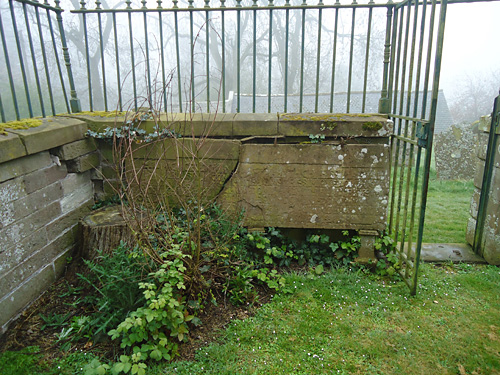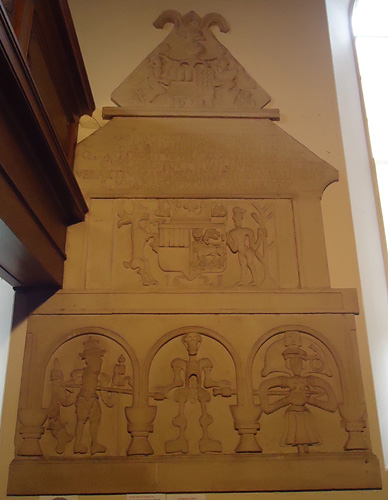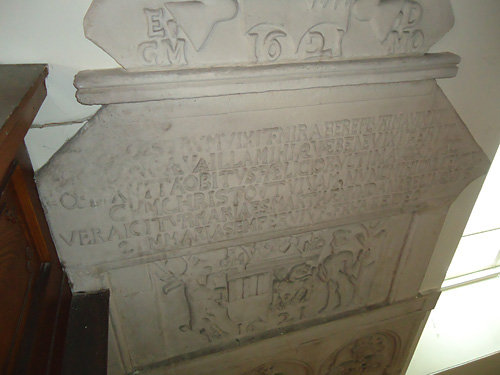Neo-Latin on Tombs: the Case of Benholm
After a summer break, our programme of 'features' now resumes for the 2014-15 academic year, and begins with a look at an untouched but substantial corpus of Scottish neo-Latin material which lies waiting to be discovered among the parish kirks all across Scotland. Post-Reformation funerary monuments, from simple recumbent slabs and tombstones to great mausolea and burial aisles, often bore Latin poems that supplemented the sculpture and the names of the deceased. Presumably these short pieces once constituted a decent portion of poetic output, representing small commissions for the jobbing poet for grateful and grieving patrons. There are several instances where we know the poet employed to write the epitaph. George Buchanan is reputed to have composed the inscription on the brass plaque commemorating Alexander Cockburn which once stood in Ormiston Parish Kirk. Until recently Buchanan was also thought to have composed the epitaph on another brass plaque in St. Giles Kirk Edinburgh for Regent Moray, although Amy Blakeway has suggested a more likely candidate was John Wood, Moray's secretary. 1 Hercules Rollock helpfully left his monogram upon the poem commemorating Adam Bothwell in Holyrood Abbey. No doubt there are countless more memorials by important Scottish poets surviving throughout the country, although the authorship of the majority will have been lost. A heavily weathered Latin poem on the ruined shell of the Kirk of Old Deer commemorating a branch of the Keith family, for example, is today almost indecipherable.
The memorial inscriptions can be of considerable value as sources in their own right and the case of Benholm in Kincardineshire will serve this point. The ramshackle medieval church of Benholm was pulled down with the help of explosives in 1832 and completely replaced with its current rectangular preaching box. When the old church was being dismantled two memorials were salvaged from the burial aisle which had occupied the old bricked-off chancel. These were re-erected on either side of the new pulpit, where they still stand today. 2 One belongs to the Scott family and dates to 1690, the other dates to 1621 and will be the focus of the following discussion. The symbolism on this memorial is quite remarkable and tells story of a household in mourning and the Latin poem upon it is fundamental to understanding the memorial's message.
The memorial was made up of five tiers and its shape suggests that it was situated at the gable end of the chancel burial aisle, which would have made it the most prominent and visible feature there. The fifth and bottom-most tier was detached when the memorial was moved and is now slowly weathering away outside in the kirkyard [Figure 1]. It bears the simple inscription: 'Hic jacet Domina Maria Keyth clarissima filia nobilissimi commitis illustrissimique Domini Georgii comitii Marescalli Domini Keyth et Altrie &c et nobilissimae clarissimaeque Dominae Dnae Margar Ogilvy Mariscalli comitissae quae foelix in Domino obiit 14 Octob Anno Domini 1620 Aetatis suae 5' [Here lies Lady Mary Keith the most beloved daughter of the most noble and illustrious earl, Lord George Keith Earl Marischal Lord Keith and Altrie etcetera and the most noble and illustrious lady Dame Margaret Ogilvy Countess Marischal, who died happy in the lord 14 October the year of the lord 1620 aged 5 years]. Although this tells us of the memorial's patrons, the craftsmen, designer and neo-Latin poet remain unrecorded.

Figure 1.
Returning inside the kirk to look at the rest of the memorial [Figure 2], the lowest tier extant today is in the form of an arcade divided into three arches and depicts, in the centre, a skeletal representation of Death holding two long spears, which are piercing two figures on either side. On the left hand side is the earl Marischal, facing Death, wearing an elaborate helmet, holding a firearm in one hand and a huge sword in his other. On the right is his wife Margaret Ogilvy, facing away from death towards the viewer, holding her hands in prayer and wearing a large collar with an O shaped jewel by her right ear. Symbolically this tier shows that despite their wealth, beauty or martial prowess, the noble parents are struck down by grief, asserting that death is universal to all. This is also emphasised by the visual pun of the levelled darts, and how death stands between them as their equal. By choosing to be depicted in this way the couple clearly show the great grief caused by the loss of their daughter. In the tier above this is an escutcheon bearing on the left the Keith arms, supported by a deer, and on the right, the Ogilvy arms of a griffon, supported by a wild man, with the initials of the earl and countess and the date 1621, when the memorial was erected. The placing of the arms here symbolically shows how their noble houses are literally and metaphorically above death, as well as conceptually more than just the temporary individuals who are their custodians, depicted below. In the next tier is a Latin poem, which shall be returned to in detail in a moment. Finally at the top of the memorial is a triangle containing another heraldic shield held by two winged angels. At face value this is a typical arrangement of a coat of arms, with escutcheon containing a family motif, two supporters (angels), a helm and crest (the deer). The supporting angels indicate that the arms represent somebody in death, meaning that this device symbolises the deceased Mary. This is also indicated by the fact that the shield contains a different symbol to the arms on the second tier to represent the Ogilvy family, that of a portcullis. The angels represent her ascension to heaven, which contrasts with the bottom tier, representing earth, where the parents are grieving. Mary's shield is also directly above the figure of Death, who is standing where she would have been in life. 3

Figure 2.
The memorial provides a momentary snapshot of Marischal's household in grief, immortalised in stone, as Mary ascends to heaven. This is a very personal expression of sorrow at the moment of death. The Reformation had forcibly detached the living from the dead, the living could not help the dead through prayer and the saintly dead could no longer influence the lives of the living. The memorial can therefore be seen as the grieving parent's way of coping with one of the most traumatic moments in any individual's life. Yet the Latin poem [Figure 3] provides consolation and guidance to the grieving parents.

Figure 3.
Vix lustrum vixit. mira bene plurima vixit
longaeva illa mihi. quae bene vixit. erit
faelix vita. obitus faelicior. ultima vox haec
cum christo ut vivam. nunc mihi dulce mori
vera igitur maria es. Marthae mundana relinquis
cum maria semper vive fruare deo.
Barely five years she lived; but for me, her years were wonderful and long. She who lived well will be blessed in life, and her death still more blest. This her final word: 'now it is sweet for me to die, so that I may live with Christ'. Therefore you are truly Mary. You leave earthly matters to Martha; with Mary, live forever and delight in God.
This uplifting poem seems to interact with various biblical passages. Mary's short but long life echoes the notions in the Old Testament book of Wisdom. Chapter three describes how the souls of the righteous will reside with God and book four, especially verses seven to fourteen, describes the idea of old age being achieved in youth, of the young person achieving perfection early and being taken by God, lest they be corrupted by wickedness. Mary's last words appear to adapt Romans 6:8, 'si autem mortui sumus cum Christo credimus quia simul etiam vivemus cum Christo' ('and if we die with Christ, we believe that we will also live together with Christ') in a passage concerning how death releases the pious individual from sin to enjoy everlasting life, a life over which death no longer has mastery (Romans 6:9). This section has a direct parallel (perhaps even the original source of the poem's phraseology) in Andrew Melville's short lyric 'Christianus Ego', especially the final line, 'Illi hinc dulce mihi vivere, dulce mori', which James Melville translates in The Comfort of a Christian as 'Therefore in Christ I sweetly liue, and sweetly sall depart'. 4
The final section of the poem is a direct reference to Luke 10:38 to 42, where Jesus visits the home of two sisters, Martha and Mary. While Martha was fussing with housework, fretting over mundane matters, Mary sat listening to Jesus and concentrating on spiritual concerns. In terms of the memorial as a whole, this is the lesson and therefore the gateway which the viewers have to pass through before progressing up to the level of Mary ascending to heaven. These various invocations of biblical precedent in the poem would have provided obvious comfort to the grieving parents, a message that they could reflect upon in those tender moments when they might visit the tomb.
Being able to understand the Latin poem is thus crucial in unlocking the meaning of the memorial as a whole. Overall, the example of Benholm is suggestive of the rich use to which Latin was deployed in post-Reformation Scotland, beyond the printed page, and a field which is well-deserving of further exploration. 5
Notes:
1: D. MacGibbon, and T. Ross, The Ecclesiastical Architecture of Scotland, vol. 2 (Edinburgh, 1896) pp.597-599, David Laing, 'Notice respecting the Monument to the Regent Earl of Murray, now restored, within the Church of St Giles, Edinburgh' in PSAS, vol. 6 (1864-1866) pp.49-55; Amy Blakeway, 'The Response to the Regent Moray's Assassination', Scottish Historical Review, vol. 88 (2009) pp.9-33, p.26.
2: J. Scott, 'Parish of Benholm' in Statistical Account of Scotland 1791-1799, vol. 15, pp.217-240 at p.223; RCAHMS 36750 (Benholm Parish Church); J. Glen, 'Parish of Benholm' in the New Statistical Account of Scotland 1834-1845, vol. 11, pp.51-65, at p.56-57; C. Rogers, Monuments and Monumental Inscriptions in Scotland, vol. 2 (London: Grampian Club, 1872), p.274.
3: Contrary to the 'Buildings at Risk' report which states the portcullis represents Marischal's role as commissioner for Parliament in 1609: http://www.buildingsatrisk.org.uk/details/916359 [accessed 07/08/2014].
4: J. Melville, Ane Fruitful and Comfortable Exhortatioun anent Death (Edinburgh, 1597) p.110.
5: Considerable gratitude is expressed to Dr Keith Stewart of the Stonehaven Heritage Society for showing me around Benholm, along with a number of other sites in Kincardineshire. Also my sincere thanks are expressed to Dr Jamie Reid Baxter for his amendments to the original translations, his comments on the biblical precedents and the James Melville lead.
Index:
- June 2015 – Adam King 2
- May 2015 – Adam King 1
- April 2015 – Transliterations 3: Thomas Maitland
- March 2015 – Transliterations 2: Robert Ayton
- February 2015 – Transliterations 1: Andrew Melville
- December 2014 – Censorship and the DPS
- November 2014 – Thomas Craig, part 2
- October 2014 – Introducing Thomas Craig
- September 2014 – Neo-Latin on Tombs: the Case of Benholm
- May 2014 – Introducing Thomas Maitland
- April 2014 – James Halkerston and Henri III
- March 2014 – Caspar Barlaeus and the DPS
- February 2014 – Latin, Print, and the Union of Crowns
- January 2014 – Buchanan: Jacobean Maecenas?
- November 2013 – Melville, Rollock, and Elegiac Meter
- October 2013 – Rollock in England, 1579-1580
- September 2013 – Hercules Rollock in France, part 2
- August 2013 – Hercules Rollock in France, part 1
- July 2013 – A poetic account of the Marian Civil War
- June 2013 – Introducing Hercules Rollock
- May 2013 – Andrew Melville and Virgil




